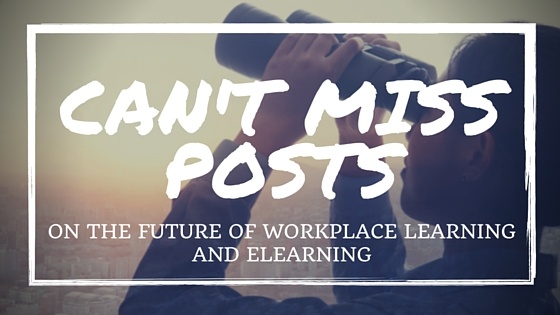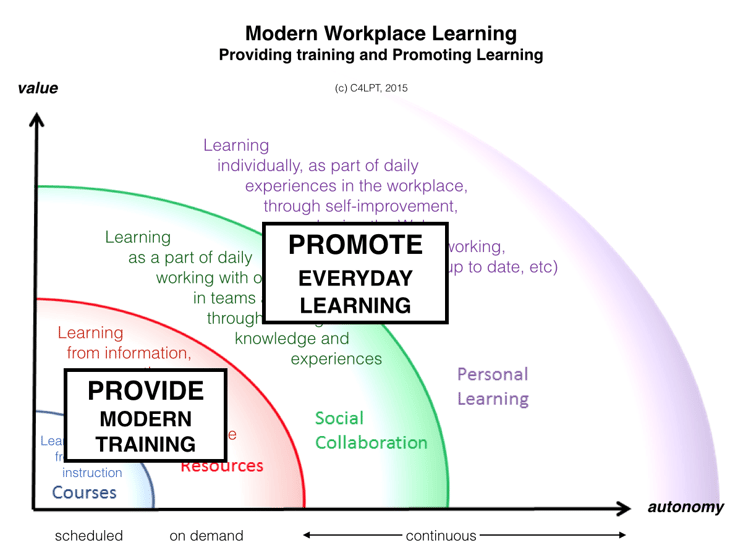There are endless blog posts that can help you understand the actual status and the future of workplace learning and eLearning, but sometimes too much information can be overwhelming. Which is why we compiled this list of 2015 posts you absolutely must read before this year ends.

1) Learning in the Modern Workplace is More than Training or e-learning
By Jane Hart @C4LPT
This article by Jane Hart suggests that companies need to abandon the traditional view of learning as packaged content and learners as the people who sign up for classes. Learning takes place all the time as people complete job tasks, collaborate with colleagues, and participate in professional networking. Small pieces of information are acquired over time, which ultimately leads to knowledge and job proficiency.
A shift in the modern workplace means that employees can learn in many ways other than only through formal learning programs.
She offers this powerful graphic:

2) Trending in Workplace Learning 2015
By Allison Rosset @arossett
Allison Rosset compiled a list of trends regarding workplace learning at the beginning of the year. Her predictions indicated that it would be personalized, customized, miniaturized, mobilized and informalized.
So how did 2015 measure up?
As Rosset ironically pointed out, casinos provide more personalization than workplace learning. Individuals benefit from more attention and more choices when gambling than through corporate learning opportunities. Not only was this a big focus in 2015 but customization was also tied into this as organizations aligned their professional development strategies to meet the needs of individual employees. Less is more continued to be a trend as training moved away from traditional course development and focused more on providing content in bite-sized and easily accessible chunks. 2015 also saw increased mobility and informality with micro-learning available through apps, blogs, and updates sent to employees’ phones and tablets.
Rosset was spot-on for learning trends in 2015, and her predictions seem to be paving the way into 2016 as well.
3) Rethinking the Future of Workplace Learning
By Helen Amery @WildFigSolns
The author’s intent in the article is to promote awareness that Learning & Development must continually evolve alongside technology in order to stay relevant. Traditional corporate training is phasing out to make way for flexible learning that meets the needs of modern work arrangements. The number of employees who still work a 9 to 5 schedule for 5 days a week is drastically reducing. Training should change to match the needs of employees, and today that means accommodating for a variety of schedules and deploying content to be accessed on devices other than just a company computer.
Training professionals should be familiar with the alternatives to traditional classroom courses. According to the author, there are significant shifts occurring in the way people learn in companies.
- Bite-size, not just feast: Content should be chunked into bite-sized pieces in order to be readily available and to match attention spans. Small bits of content at a time are easier for employees to absorb in between other job-related tasks.
- Social, not just formal. Rather than watching an instructor, people learn by doing and by sharing their experiences with others. An abundance of digital resources is available that allow people to experience this social connection with others, and, therefore, face-to-face settings are not as important in the training world as they once were.
- From prescription-based to user-choice training. One-size fits all training courses are no longer useful. Not only do employees work in different ways, but they also learn in different ways. The implication is that personalized content should be delivered in a variety of methods so that employees can opt to participate in the training that works best for them.
By understanding these critical shifts in the industry training professionals can adopt programs to meet the changing needs of employees today.
4) What the Future of eLearning Looks Like
By Phil Eagles from Bray Leino Learning @BrayLearning
Technology changes so rapidly that it is almost impossible to predict the eLearning landscape for 5 to 10 years down the road. Phil Eagles made his best guess at future trends based on what is happening in the industry today. He expects advancements in technology to lead to increased gamification, automation, and augmented learning. Augmented reality technology already exists, and it is only matter of time before it changes the way we learn.
Personalization and mobility, both major trends in 2015, will continue to expand making customized content only a click away. Cloud-based LMS systems will lead to increased eLearning development due to faster deployment and lower costs.
While no one can predict the future, according to Eagles there is a lot to look forward to in the eLearning industry!
5) Is Learning Increasingly Self-Directed in the Digital Era?
By Suren Ramasubbu, Co-Founder & CEO of Mobicip.com @surenram
Self-directed learning is more prevalent now than ever due to a combination of 24/7 Internet accessibility as well as an entire generation of digital natives entering the workforce. Individuals are taking control of their own education by setting learning goals, exploring open-ended resources, and evaluating their own outcomes. Students become more motivated based on the independence and autonomy fostered through self-directed learning.
The author proposes that educators use technology as a way to cultivate self-directed learning. By giving students the tools to learn and encouraging the freedom to explore, teachers can transition learning to be student-centered.
As digital natives populate the workforce, the trend for self-directed learning will continue to grow. Therefore, HR professionals should incorporate this type of learning in their training programs to keep students engaged. They should create learning environments that encourage digital exploration, include meaningful activities, and incite critical thinking at least.
6) Study Highlights the Changing Face of Enterprise Learning
By Jamie Scott, Intercall
Elearning has changed the ways companies do business and how they train their employees. A recent study conducted by Elearning!Magazine shows how eLearning investments increased 9% in 2014, compared to 2013. Therefore, it right to say that eLearning's popularity is growing - its changing the way companies train and engage their workforce.
According to the study, 75% of the respondents used eLearning development tools and 61% of employee training has taken place outside of a traditional classroom context. Companies are investing time and resources revamping their learning programs based on the need to increase employee engagement as well as increased workforce globalization. Compliance is still the number one type of training being implemented via E-learning,
What trends do you predict for 2016? How will these affect the type of training you create?








